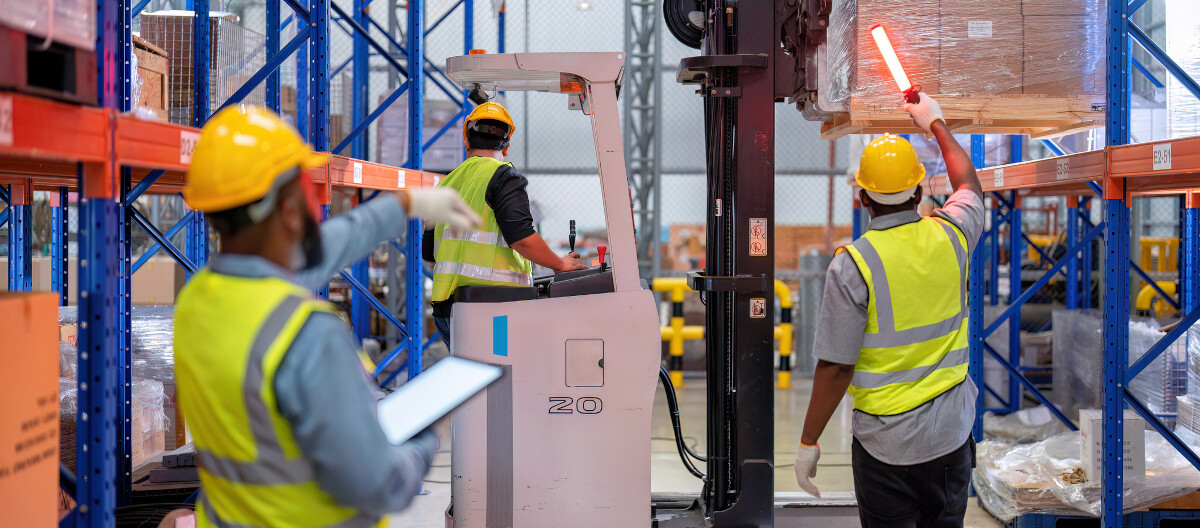How does future-facing intralogistics work?
State-of-the-art drive and automation technology modernizes many of the elements and processes in intralogistics. This can be achieved through the use of modern, more efficient conveyor systems, storage and retrieval machines and lifting gear which are deployed in a decentralised way, or by simultaneously replacing the entire loading and storage technology. This technology also introduces new, digital approaches to controlling and monitoring processes: we’re now familiar with concepts like the Internet of Things (IoT) and artificial intelligence (AI). Many companies can benefit from this combination of state-of-the-art technology and software. For established companies, which have evolved over time, intralogistics is often based on tried and tested concepts which are now out of date. While these methods may continue to work internally, they limit a company’s competitiveness in today’s market.
Here’s an overview of the advantages that future-facing drive and automation technology can bring to intralogistics.
- The ability to react quickly to changing customer demands
- Independent automation of a number of processes in distribution, production and maintenance
- Cost benefits through the easy exchange of individual elements in decentralised intralogistics
- Relatively simple scalability
- Reduced risk of total failure compared to a continuous intralogistics chain, since the individual elements are easily interchangeable or replaceable
Which automation technologies are fit for the future?
In this context, modular systems play an important role in the production environment. They eliminate the need for time-consuming central organisation: instead, they act largely autonomously in their intended area of operation and respond directly to current demands. This is made possible by their largely independent, internal power and control electronics, which ensure self-administration and self-organisation of the individual components. While this does not replace the end-to-end networking of the logistics modules, it significantly reduces the effort involved. All of this takes place within a modular system, in which the modules each take on the role of functional, easily combinable and reusable standard elements. Thanks to this flexibility, it’s possible to have different material flow strategies in one place.
This is the goal of the drive and automation technology of the future: rapid adaptability, regardless of individual concepts and organisational setups. This includes effective cooperation between humans and machines, holistic and lean networking (both internal and external) and proactive data analysis. Here are a few examples:
- “Intelligent” robots or autonomous production and conveyor units make it possible to achieve the most comprehensive level of automation. Whatever your field of work, it will expand greatly due to technological progress. This frees up your employees to spend their time on more challenging tasks.
- When it comes to the relationship between people and technology, augmented reality (AR) and wearables will also become more important in intralogistics. AR glasses, for example, display hints and tips in the employee’s field of vision during certain work processes. Smart wristbands and gloves help to recognise and classify goods and collect related data.
- The use of artificial intelligence (AI) and machine learning offers further opportunities for intralogistics. Both technologies are not only well suited for data analysis, but can also make informed decisions based on this analysis.
- Cloud computing and digital platforms will continue to consolidate and optimize the exchange of data among all stakeholders within a supply chain – and also in intralogistics.
How can we successfully integrate these techniques into existing systems?
The best option for the use of future-facing drive and automation technology is a complete shift away from the previous components of the flow of materials. However, this radical approach will require considerable effort and time. This means it’s almost impossible to prevent downtimes within intralogistics. One alternative is a partial changeover, in which old structures are gradually replaced by new ones.
However, both approaches require structured planning. The decisive factor here is to consider the specific circumstances and needs of the individual company, which must be clarified in detail. As a general rule, it’s sensible to follow this procedure:
- Start with an inventory that relates not only to intralogistics, but also to its interaction with other departments or, ideally, even with external stakeholders. Here, we need to identify areas where there are frictional losses not only in the flow of materials itself, but also as this relates to other areas. This shows where there is room for improvement.
- Carry out a needs-based analysis based on the current situation. This must show where processes can currently be optimised (from receiving goods through to storage and shipping), as well as which criteria are important for the further conceptualisation of intralogistics. Firstly, the agility of the entire supply chain: this is a central point of preparation which goes far beyond intralogistics itself, so it must be discussed thoroughly and in collaboration with all departments involved.
- Don’t forget to take the time frame into account. Firstly, you need to think about the planned completion of the project. Secondly, you need to consider the future lifespan of the measures you’ve implemented. Are you looking at five years, ten years or more? You’ll need to always keep an eye on technological developments and reacting appropriately where necessary. This is easier to achieve with modular intralogistics than with a complex, uniform system.
- Based on the above, determine the financial, technical and time requirements of the practical implementation. It’s not always possible to tackle this challenge internally, in which case it would be worth seeking outside support to help during this demanding transitional phase.
